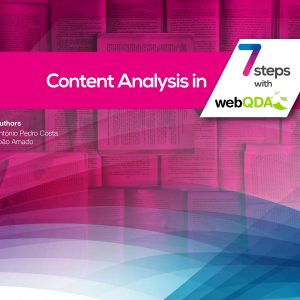General tips for encoding Qualitative Data


António Pedro Costa, University of Aveiro
One of the main errors verified in research is the lack of planning of adequate methods for data analysis. For example, to develop a data collection instrument, it is necessary to pay attention to the tools used to obtain results (analysis).
Analysing qualitative data is not a task without difficulties, as the non-numeric and unstructured data corpus is generally diffuse and complex. There are no clear and widely accepted rules on how to analyse non-numeric and unstructured data. There are general approaches, which should always be adjusted to the context of each research project, and basic operations, particularly coding, about which some general tips will be presented here.
Matheus & Fustinoni (2006) argue that:
“the purpose of data analysis is to organise, provide structure and extract meaning from the research data. Transcripts must be read, reread, and then organised, integrated, and interpreted, and the final challenge is to reduce the data for reporting purposes. Thus, we can say that qualitative analysis is a process of investigation, interpretation, reduction and ordering of data to reach the description or explanation of a phenomenon” (p. 141).
Morse (2007) adds that data analysis is:
“a process that requires intelligent questioning, a continuous search for answers, active observation and accurate memory. It is a process of joining and merging data, making the invisible obvious, distinguishing the significant from the insignificant, linking seemingly unrelated data, relevant categories into each other and attributing consequences to antecedents. It is a process of conjuncture and verification, correction and modification, suggestion and defence. It is a process of organising so that the analytic scheme appears obvious” (p. 35).
The main general actions in data analysis can be configured according to the following topics (Costa & Amado, 2018; Bardin, 2014):
- Work with the data;
- Data organisation;
- Division of data into manipulable units;
- Data synthesis;
The following four actions can be facilitated using a Computer-Assisted Qualitative Data Analysis Software (CAQDAS), as is the case with the webQDA software (2019) – webqda.net:
- Search for patterns (speech, behaviour, among others);
- Discovery of the essential aspects of the data;
- Discovery of what must be learned from the data;
- Decision on how to transmit data to third parties.
For those starting the qualitative data analysis, or those who have already initiated but need to clarify, a proposal with procedures is shared here, applied in training, seminars, workshops, and webQDA webinars (2019). Steps:
- Read all initial data: transcripts, field notes, documents, etc.
- Start encoding after data collection;
- Repeat the process with the new data that is added;
- Always review the encodings;
- Consider general theoretical ideas about the data;
- Consider the categories (in webQDA designated by codes) created concerning the research questions and objectives;
- Any item or piece of data can be encoded in more than one way;
- Initially, do not consider whether the creation of categories seems too much, as it varies depending on the method and technique of data analysis explored. If you are using Grounded Theory, following the traditional model, initially, categories are proposed through the floating reading of the data (free codes) and only in the second reading are categories reduced;
- Review the balance between defining the category or creating a new category or sub-category: depending on the number of reads made to the encoded data, it may be more appropriate to change the definition of a category to encompass new encodings than to create a new category;
- Create a “pendular movement” of expansion and synthesis of categories: following the inductive model (Costa & Amado, 2018) in which the categories emerge from the active reading of the data, usually in the first reading, many categories are proposed – expansion – and in a second one, the reduction of categories is made – synthesis;
- Constantly ask questions to encodings: What for? Why? What is the meaning? What relationship?
The previously presented proposal can and should be adjusted according to the researcher’s skills when analysing their data. The previous proposal can be defined as a starting point, which should not be binding unless the researcher so decides.
References
Costa, A. P., Moreira, A. & Souza, F. N. de (2019) ‘webQDA – Qualitative Data Analysis’. Aveiro – Portugal: Aveiro University and MicroIO. Available at: www.webqda.net.
Costa, A. P. & Amado, J. (2018) Content Analysis Supported by Software. 1a. Oliveira de Azeméis – Aveiro – PORTUGAL: Ludomedia.
Bardin, L. (2014) Análise de Conteúdo. 3a. Edições 70.
Matheus, M. C. C. & Fustinoni, S. M. (2006). Pesquisa Qualitativa em Enfermagem. São Paulo, Livraria Paulista Editora.
Morse, J. M. (2007). Aspectos essenciais de metodologia de Investigação Qualitativa. Coimbra: Formasau.



